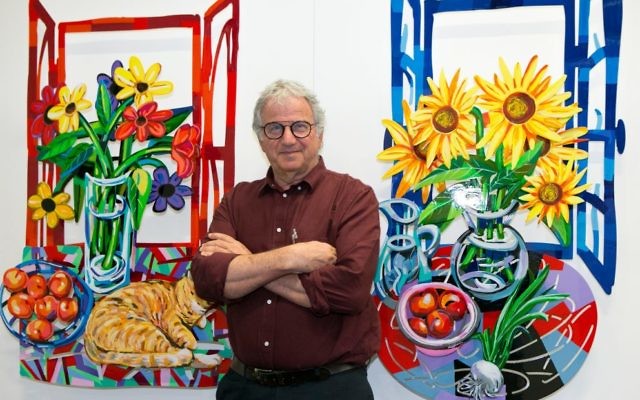Gerstein’s gift to society
Bold pops of colour weave through Israeli painter and sculptor David Gerstein's artworks, which were exhibited as part of JNF Green Week. Sophie Deutsch reports.
INSPIRATION often strikes at the most unlikely of times.
During his army service, David Gerstein was dismantling cardboard boxes when he began drawing sketches on the partition that holds the bullets.
“I was sketching on it and put it together, and all of a sudden I realised that I can make a painting that stands,” Gerstein remarked, rejoicing in his moment of creative enlightenment during a brief reprieve from setting up his striking masterpieces at The Venue in Alexandria for JNF Green Week.
After his initial spark of inspiration, Gerstein told The AJN: “I came back to my studio and started to cut out different shapes and paint over them … I got rid of the background and left the motif, and created a construction.”
The end result was striking – a unique kaleidoscope of colour merged painting with sculpture, and signified Gerstein breaking new ground in the art world.
“In the beginning, I was a figurative painter and I did very well with it, but I felt that I didn’t say anything new to the world, [and] I had a desire to leave a mark,” he said. “That’s why I wanted to find my own language.”
But, he asserts, his loyalty as an artist still lies with painting.
“Today, people call me a sculptor, but I still feel that I am a painter. I am a painter who does 3D works and extends the border of painting into space.”
Branching outwards beyond the confines of 2D form, Gerstein’s vivacious colour palette is irrepressible.
It’s no wonder his artistic style is often referred to as post-pop art.
Colour, throughout evolution, has always sought to lure the viewer closer, according to Gerstein. “Why is fruit so colourful? Why are oranges such a strong orange? Why is the lemon so yellow? … They are supposed to attract attention. That’s why nature created them [to be] colourful, and I use the same strategy.”
“Once they attract, [people] start to discover other things, and discover there is a vitamin in the fruit, there are calories in the fruit, there is a substance in the fruit.
“It is not just to attract the eye, but later to attract the mind.”
The evolutionary strategy Gerstein draws on is certainly proving fruitful – it’s difficult to cast your eyes away from the artist’s bold, beautiful and often, very big works.
His biggest work to date, and according to Gerstein, his most impressive so far, is Singapore’s now tallest public sculpture, Momentum.
Sitting in the heart of Singapore’s CBD, the red conical sculpture depicts society’s upward progression as locals work together to build a thriving, world-class metropolis.
“I like the fact that [outdoor art] is in a public domain and that people can enjoy it and own it, but not physically own it,” said Gerstein.
“If I sell [art] to a collector, I will never see it again, and maybe three or four people will see it in a home, but when you do public art, it belongs to the public … It is my gift to society.”
The fusion of forms suggests art now lies more on a spectrum, rather than being easily slotted into definitive categories.
In Gerstein’s case, the integration of painting with architecture has enabled his memories, through art, to meld into a city’s skyline.
But while big and bold are important, Gerstein also believes in the simple power of small pieces of art, whether of childhood experiences, cycling, nature, people, animals or any other scene that forms part of his living memory.
“When my art became more expensive, I decided to make small works that would be very low budget works that could be sold in museum shops, so even people that have very little budget can own one of my works and have it in their home … I had some friends that told me, ‘we only work for the museum curator. We don’t care for the public.’ I am the opposite. I don’t care so much for the curator, I want to please the public. It is my role in life, to make the world nicer, friendlier, happier.”
It is fitting then, that 50 per cent of the proceeds from the sale of Gerstein’s artworks at last week’s exhibition will go towards bettering Israeli society through JNF’s project with Make-A-Wish Israel. Funds are being allocated towards the construction of a green therapeutic garden and playground at a major Israeli hospital, and granting wishes to critically ill children in the south of Israel.
SOPHIE DEUTSCH


comments